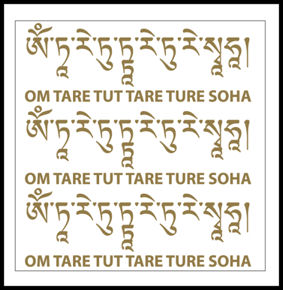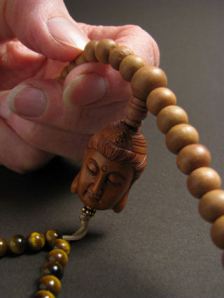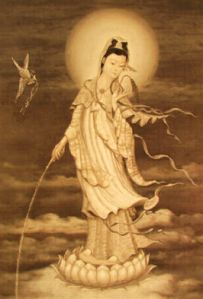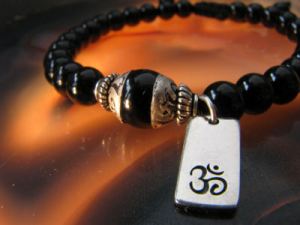by Thea Cowsky
 What is mantra?
What is mantra?
Mantra is a series of sacred sounds or syllables that are repeated over and over and carries spiritual energy as it is expressed. In Sanskrit ‘man’ means to think and ‘tra’ means to protect or to free from (the bondage of the phenomenal world). So recitation of mantra is a protection of the mind by focusing and purifying.
The mantra is repeated over and over as a prayer, meditation, invocation or object of concentration. It can be one syllable or several syllables.
Using the mala

The mala is the tool used while reciting mantra that helps to focus the mind and to count repetitions of the mantra. It represents a flow of nectar as one is reciting the sacred sounds. A Buddhist mala and Hindu (japa) normally have 108 beads.
Starting Mantra Meditation Practice
The Buddhist tradition teaches one to adjust your motivation so that you wish to do the mantra recitation for the benefit of all living beings. This increases the positive effects for others as well as oneself.
The mala is held in the left (receiving) hand while reciting. The mala can be held at the level of the heart as an expression of devotion if you wish. The beads of the mala are moved one by one as the mantra is recited, starting next to the larger central ‘Guru bead’ which represents Buddha, God, The Eternal. When you reach the Guru bead again the mala is turned and you continue on in that direction. Since the Guru bead represents the Buddha or the Devine, one does not cross over it.
It is sometimes said that mantra sounds like the buzzing of bees, loud enough to hear but not ‘loud’.
Formal mantra practice is nice to do early in the morning when the mind is most clear and the environment is most calm. Mantra can also be done any time during the day to bring the mind back to center and connection with the heart-mind. Reciting mantra and holding your mala can be very supportive anytime of day or night. Using mantra in challenging times or during lunch break helps to refocus and renew.
See Tara Mantra, or instructional aids (cd’s & books).
Contributing author Kate Cowsky







